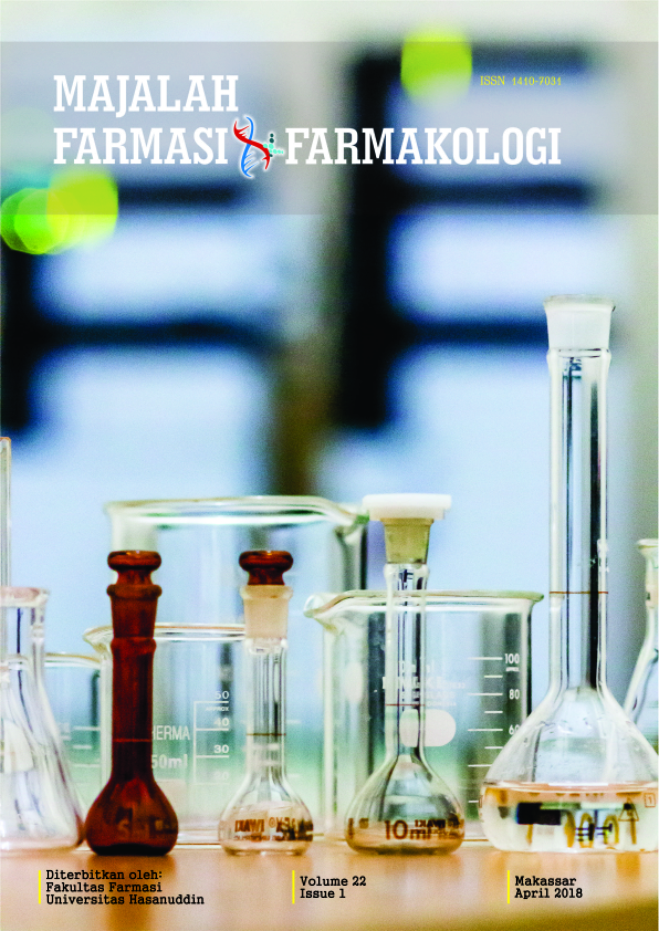PENETAPAN KADAR PARASETAMOL, KAFEIN DAN PROPIFENAZON SECARA SIMULTAN DALAM SEDIAAN TABLET DENGAN METODE KCKT
Abstract
Parasetamol, kafein dan propifenazon dikombinasikan bersama dalam sediaan obat untuk memberikan efek analgetik. Penggunaan kombinasi obat semakin meningkat untuk mencapai efek terapi yang lebih baik dan penurunan toksisitas sehingga sangat penting untuk mengawasi kandungan zat aktif dalam formulasi farmasetik. Desain penelitian adalah eksperimental menggunakan metode Kromatografi Cair Kinerja Tinggi (KCKT) dengan detektor UV pada 273 nm, kolom ODS, fase gerak metanol dan air (50:50), laju alir 0,6 mL/menit dan volume penyuntikan 20 µL. Pada penelitian ini dilakukan uji kesesuaian sistem, serta penentuan presisi dan akurasi metode analisis. Hasil penelitian diperoleh uji kesesuaian sistem memenuhi syarat dengan standar deviasi relatif (RSD) waktu retensi dan luas puncak ketiga analit < 2%, dengan waktu retensi parasetamol, kafein dan propifenazon masing-masing pada 5,41, 6,33 dan 24,11 menit. Rata-rata hasil penentuan presisi parasetamol, kafein dan propifenazon berturut-turut sebesar 94,461±1,687; 94,642±1,768; dan 99,177±1,871% yang memenuhi persyaratan USP (90-110%) dengan RSD presisi 1,79; 1,87 dan 1,89% yang memenuhi kriteria penerimaan (≤ 2%). Rerata hasil akurasi parasetamol, kafein dan propifenazon menggunakan kadar 80, 100 dan 120% yaitu 99,732±0,949; 101,260±1,331 dan 99,700±1,506% memenuhi persyaratan rekoveri yaitu 98-102% untuk parasetamol dan kafein serta 97-103% untuk propifenazon. Berdasarkan hasil presisi dan akurasi maka metode penetapan kadar parasetamol, kafein dan propifenazon secara simultan menggunakan KCKT memenuhi persyaratan.
References
Chaudhary, J., Jain A., and Saini, V. 2011. Simultaneous Estimation of Multicomponent Formulations by UV-Visible Spectroscopy: An Overview. International Research Journal of Pharmacy. 2(12), 81-83.
Tsvetkova, B.G., Kostova, B.D., Rachev, D.R. Pelkova, L.P. and Pencheva, I.P. 2013. HPLC Assay and Stability Studies of Tablets Containing Paracetamol and Caffeine. International Journal of Pharmaceutical Sciences Review and Research. 18 (1) : 138-142.
Ikatan Sarjana Farmasi Indonesia. 2002. Informasi Spesialite Obat Indonesia. Edisi XXXVI. Jakarta. 47, 218.
Adupa, S., Adupa, S., Simhadri, H., and Kalidindi, S. V. 2014. Simultaneous Estimation of Paracetamol Caffeine and Propyphenazone in Bulk and Pharmaceutical Dosage Form by RP-HPLC. Journal of Pharmacy Research, 8 (3) : 331-335.
Delvadiya, K., Kabra, P. Kimbahune, R. Patel, N. and Nargund, L. 2013. High-performance Liquid Chromatographic Determination of Paracetamol, Propyphenazone, and Caffeine in Pharmaceutical Formulations. Indian Journal of Pharmaceutical Education and Research, 47 (4) : 65-72.
Yuwono, M., Indrayanto, G. 2005. Validation of Chromatographic Method of Analysis. Profiles of Drug Substances, Excipients, and Related Methodology. 32 : 243-259.
Harmita. 2004. Petunjuk Pelaksanaan Validasi Metode dan Cara Perhitungannya. Majalah Ilmu Kefarmasian. 1 (3) : 117-135.
Ahuja, S., and Dong, M.W. Eds. 2005. Handbook of Pharmaceutical Analysis by HPLC. 1st Edition. United Kingdom : Elsevier Inc. 191-217, 401-412.
Ditjen POM. 1995. Farmakope Indonesia. Edisi IV. Departemen Kesehatan Republik Indonesia. Jakarta.
Gupta, V., Jain, A. D. K., Gill, N. S. and Gupta, K. 2012. Development and Validation of HPLC Method. International Research Journal of Pharmaceutical and Applied Sciences. 2 (4) : 17-25.
Huber, L. 2007. Validation and Qualification in Analytical Laboratories. 2nd edition. Informa Healthcare USA Inc.125, 141, 144, 146.
Kar, A. 2005. Pharmaceutical Drug Analysis Revised 2nd edition. New Age International Publisher. 455.
Kazakevich, Y., and Lobrutto, R. Eds. 2007. HPLC for Pharmaceutical Scientists. Wiley-Interscience. A John Wiley & Sons Inc. 417
Kupiec, T. 2004. Quality-Control Analytical Methods: High-Performance Liquid Chromatography. International Journal of Pharmaceutical Compounding. 8 (3) : 223-226.
Moffat, A. C., Osselton, M. D. and Widdop, B. 2005. Clarke’s Analysis of Drug and Poisons. Pharmaceutical Press.
Ravisankar, P., Navya, C. N., Pravallika, D., and Sri, D. N. 2015. A Review on Step-by-Step Analytical Method Validation. International Organization of Scientific Research (IOSR) Journal of Pharmacy. 5 (10) : 7-19.
Riyanto. 2002. Validasi dan Verifikasi Metode Uji : Sesuai dengan ISO/IEC 17025 Laboratorium Pengujian dan Kalibrasi. Deepublish. 18, 39.
United States Pharmacopeial Convention. 2016. The United States Pharmacopeia 39-National Formulary 34 (USP39-NF34). 39th Edition.
Rockville USA. United States Pharmacopeial Convention Inc. 6-10 <621>, 1-5 <1225>.
Watson, D. G. Eds. Terjemahan Winny R. Syarief. 2009. Analisis Farmasi : Buku Ajar untuk Mahasiswa Farmasi dan Praktisi Kimia Farmasi. EGC. 314.
Downloads
Published
Issue
Section
License
The copyright to this article is transferred to Universitas Hasanuddin (UNHAS) if and when the article is accepted for publication. The undersigned hereby transfers all rights in and to the paper including without limitation all copyrights to UNHAS. The undersigned hereby represents and warrants that the paper is original and that he/she is the author of the paper, except for material that is clearly identified as to its original source, with permission notices from the copyright owners where required. The undersigned represents that he/she has the power and authority to make and execute this assignment.
We declare that:
- This paper has not been published in the same form elsewhere.
- It will not be submitted anywhere else for publication prior to acceptance/rejection by this Journal.
- A copyright permission is obtained for materials published elsewhere and which require this permission for reproduction.
Furthermore, I/We hereby transfer the unlimited rights of publication of the above-mentioned paper in whole to UNHAS The copyright transfer covers the exclusive right to reproduce and distribute the article, including reprints, translations, photographic reproductions, microform, electronic form (offline, online) or any other reproductions of similar nature.
The corresponding author signs for and accepts responsibility for releasing this material on behalf of any and all co-authors. This agreement is to be signed by at least one of the authors who have obtained the assent of the co-author(s) where applicable. After submission of this agreement signed by the corresponding author, changes of authorship or in the order of the authors listed will not be accepted.


